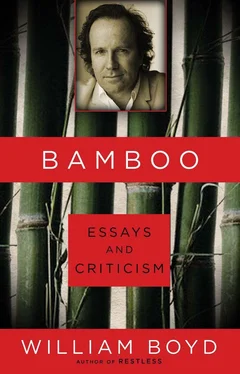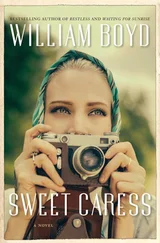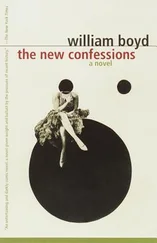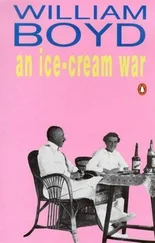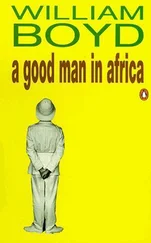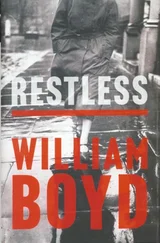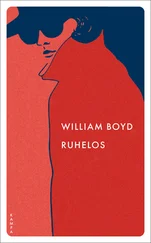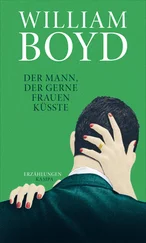The very nature of the religious and allegorical sequences, the faux naïf Beatitudes, and the domestic scenes place them in a different category. Here are the products of a highly personalized and maverick imagination, in the line of William Blake and Samuel Palmer. It is their very strangeness, their self-contained and self-assured idiosyncrasy that either enchants — or not at all. But in the astonishing portraits and double portraits of himself and his wives and a handful of other pictures Spencer reveals himself as an artist of major and enduring stature. All great art is unsentimental, and this is art of an honesty that is transcendent and magisterial in its formal accomplishments.
1991
Looking at the “by the same author” list on the fly leaf of Robert Hughes’s latest book, Barcelona , published a few months ago, it is clear that we have been the happy recipients of an explosion of productivity. It began in 1987 with the expansive and masterly history of the discovery and colonization of Australia, The Fatal Shore , and has continued apace. It was followed by two monographs — one on Lucian Freud (1988) and one on Frank Auerbach (1990) — a new edition of The Shock of the New (1991), his survey of twentieth-century art, and a weighty collection of his articles, Nothing If Not Critical (1991). Six substantial publications in five years represents an output of Ackroydian prolixity, a veritable torrent of creative juices all the more impressive when one notes that, apart from The Shock of the New , the publication listed before The Fatal Shore’s appearance in 1987 was Heaven and Hell in Western Art , published in 1969. What had Hughes been doing during all those years between? The answer is: writing art criticism (and, doubtless, researching and writing The Fatal Shore) . Hughes has been art critic for Time magazine since 1970; notching up a near quarter century as the art world’s most acute and uncompromising observer and interpreter. His position is pre-eminent and unchallenged: he is far and away the best art critic of his generation.
The reissue of the The Shock of the New provides a handy opportunity to reassess Hughes’s achievements. A swift random collation between the two books threw up no examples of editorial doctoring, except, as might be expected, in the final chapter, “The Future that Was,” which has been significantly altered. The first edition signed off in 1980 and, a decade and more further on, the scene had changed dramatically. Hughes’s conclusion in 1980 was gloomy, but one could detect an undertone that was cautiously upbeat. In the new edition his despair, not to say contempt, is conspicuous. That the worst excesses of the art market, with its obscene inflation of value, along with a frenzied hyping of reputation and image-mongering, have been played out in his own backyard, so to speak, probably explains Hughes’s dismay, but his savage indignation makes a potent fuel for his criticism. Hughes is an exceptionally fine writer and, as with many great critics, it is scorn and vituperation which set his pen bulging with spleen, but, in castigating the minor talents and ego-driven poseurs, he negatively defines what he regards as positive and estimable. As he excoriates the prancings and posturings of the contemporary art world, a credo emerges and, so I contend, sets standards of evaluation, creates parameters of excellence, which are very hard to refute. (Interestingly enough, his approbatory gaze has crossed the Atlantic and heavily favours figuration. The expanded final chapter makes it clear that Hughes regards certain British artists as repositories of those qualities he admires. As well as Freud and Auerbach the list includes Hockney, Hodgkin, Bacon, Kitaj and Kossoff.)
If the fundamental function of criticism is to make a value judgement, to establish a system of ranking, to say why this is good and that is mediocre, and in so doing to explain and justify why the critic believes this to be the case, then Hughes’s work over the years is as consistent and thorough as any. Of course all criticism is subjective, and of course it is just an expression of opinion, but in any argument the best arguer wins, other opinions are altered thereby and a consensus emerges. It is not set in cement, true, but broadly speaking, as a result of informed and intelligent critical discourse, standards are laid down and ideals are established which, if they are to be overturned by alternative criteria, have to be equally convincingly propounded and defended in their own right. This is the essence of the critical dance, if you like, and no one trips the light fantastic more effectively than Hughes.
Consider this statement, for example, which comes from Hughes’s terrifyingly effective critical demolition of Julian Schnabel:
Every significant artist of the last hundred years, from Seurat to Matisse, from Picasso to Mondrian, from Beckmann to de Kooning was drilled (or drilled himself) in “academic” drawing — the long tussle with the unforgiving and real motif which, in the end, proved to be the only basis on which the great formal achievements of modernism could be raised. Only in this way was the right to radical distortion within a continuous tradition earned, and its results raised above the level of improvisory play.
As a critical yardstick this seems to me unimprovable. Set this to work and see what it does for you. What winnowing! What wheat separated from chaff! Suddenly it feels like a window has been flung open in a hot and foetid room to admit a cool and vital breeze. Clear-eyed, refreshed, we can now see artist X and artist Y for what they truly are; stripped of obfuscation and meretricious jargon, they can be safely consigned to the crowded spielraum of fraudsters and hacks, no-talents and airheads. This is the function of good criticism; this is the crucial purpose of evaluation, and this is what Hughes has been doing for the last couple of decades with commendable rigour and unflagging energy.
It is not enough merely to expose failings and denigrate, even though, by extension, an alternative canon will inevitably emerge. But Hughes also writes with genuine enthusiasm and his tastes are eclectic and range throughout art history, as a glance at the contents page of Nothing If Not Critical will attest. But even in an area where you would expect his critical Geiger counter to be bleeping violently he seeks to extract whatever merit he can. The case of “Land Art”—the physical shaping of a terrain, the arrangement and manipulation of natural phenomena in situ —is instructive. Hughes writes of Complex One by Michael Heizer, a large geometrical hill of rammed earth, bookended by triangles of reinforced concrete set in the Nevada desert:
Seen in isolation on the desert floor, under the pale burning blue skin of the sky, with the low sagebrush stretching away to the sun-charred and eroded rocks of the girdling range, Complex One is a magnificent and gratuitous spectacle… Even its minatory look, suggesting a bunker or an abandoned installation, seems proper to the site — the edge of the Nevada nuclear proving grounds.
Whatever you may feel about “Land Art” as an aesthetic concept, you must admit that Hughes’s refusal to sneer at this Ozymandian gesture, and instead to try and capture what is impressive about Complex One , is admirable — and entirely successful. It helps, of course, if you can write as well as that. Intriguingly, in the 1991 edition, these lines have been subtly altered. The skin of the sky is no longer “pale” though it is still “burning blue,” and the sun-charred rocks have gone also, leaving only the “eroded girdling range.” “Le style est l’homme même”—Buffon’s old saw is very apposite when contemplating Hughes’s achievement. His style is not flowing and limpid, it has a knotted, intense quality, heavily adjectival and adverbial, with a large and precise vocabulary and a powerful forensic spin to his sentences. There is nothing evanescent or moody in Hughes’s writing. His approach reminds me of those lines of Seamus Heaney in his early poem Digging:
Читать дальше
